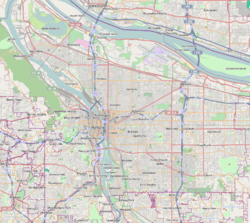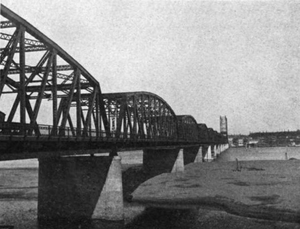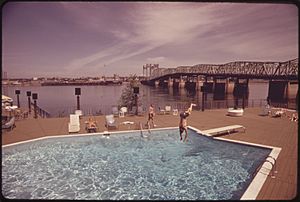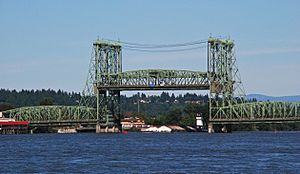Interstate Bridge facts for kids
Quick facts for kids Interstate Bridge |
|
|---|---|
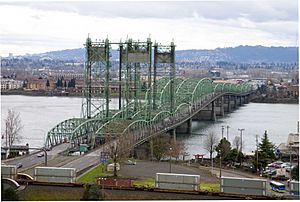
Looking south from Vancouver
|
|
| Carries | 6 lanes of |
| Crosses | Columbia River |
| Locale | Portland, Oregon to Vancouver, Washington |
| Maintained by | Oregon Department of Transportation |
| ID number | 01377, 07333 |
| Characteristics | |
| Design | Dual truss with vertical lifts |
| Total length | 3,538 ft (1,078 m) |
| Width | Northbound span 38 ft (12 m); southbound span 39 ft (12 m) |
| Height | 242 ft (74 m) |
| Longest span | 531 ft (161.8 m) |
| Clearance below | 72 ft (21.9 m) at highest fixed span; 176 ft (53.6 m) at open lift span |
| History | |
| Designer | Waddell & Harrington |
| Opened | February 14, 1917(Northbound span), 1958 (Southbound span) |
|
Portland–Vancouver Highway Bridge
|
|
| Location | Portland, Oregon; Vancouver, Washington |
| Built | 1915–16 |
| MPS | Historic Bridges/Tunnels in Washington State TR |
| NRHP reference No. | 82004205 |
| Added to NRHP | July 16, 1982 |
| Statistics | |
| Daily traffic | 132,592 (2014) |
The Interstate Bridge is actually two very similar bridges. They are made of steel and can lift up in the middle. These bridges carry Interstate 5 traffic. They cross the Columbia River between Vancouver, Washington and Portland, Oregon in the United States.
The first bridge opened in 1917. It was used for traffic going both ways. A second bridge, which looks almost the same, opened in 1958. This second bridge carries traffic going south. Both bridges are over 3,500 feet (1,067 meters) long. Each bridge has three lanes for cars. Together, they handle about 130,000 vehicles every day. In 1982, the bridge was added to the National Register of Historic Places. This means it is considered an important historical site.
Since 2005, people have talked about replacing the bridge. The bridge causes traffic jams for both cars and boats. A project called the Columbia River Crossing (CRC) was planned. It aimed to build a new bridge. This project was very expensive and caused a lot of debate. In 2013, the CRC project was stopped. However, a new effort to replace the bridge started in 2017. It is called the Interstate Bridge Replacement Program. Many different groups from Oregon and Washington are working together on it.
Contents
Building the First Bridge (1917)
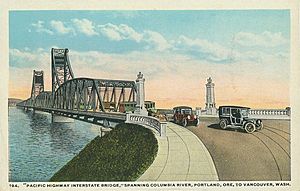
Before the Interstate Bridge was built, people crossed the Columbia River by ferry. The ferries were often very crowded.
Plans for the first bridge began around 1912. Local communities helped raise money for it. Portland contributed $1.5 million and Vancouver added $500,000. The company Waddell & Harrington designed the bridge. Construction started in March 1915. The bridge officially opened on February 14, 1917. It cost about $1.75 million to build. Clark County paid $500,000 and Multnomah County paid $1.25 million.
The first bridge has 13 steel sections. Three sections are 275 feet (84 meters) long. The other ten sections are 265 feet (81 meters) long. The bridge rests on strong supports called piers. These piers go deep into the ground. One of the 275-foot sections is a special lift span. This part can move up to let boats pass underneath. When fully raised, it provides 176 feet (54 meters) of space below. The towers that lift this section are 190 feet (58 meters) tall.
The original road on the bridge was 38 feet (12 meters) wide. It also had a 5-foot (1.5-meter) wide sidewalk. This was the first bridge for cars across the Columbia River between Washington and Oregon. It was also the second bridge to cross the river anywhere. At first, it was a toll bridge. Cars or horse riders had to pay 5 cents to cross. In 1928, the states of Washington and Oregon bought the bridge. They stopped charging tolls the next year. The Oregon Department of Transportation became responsible for keeping the bridge in good shape.
Electric streetcars also used the bridge. They ran from 1917 until 1940. The bridge deck had special tracks for them. Before the bridge, streetcars went to Hayden Island. Passengers then took a ferry to Vancouver. Streetcar service on the bridge stopped on September 3, 1940.
In 1957, the bridge became part of the new Interstate 5 highway. Before that, it was part of U.S. Route 99.
Adding a Second Bridge and Upgrades
By 1948, the first Interstate Bridge was very busy. Over 30,000 vehicles used it every day. After World War II, officials in Oregon started planning for the traffic. They decided that adding more lanes to the old bridge was not possible. So, they proposed building a second bridge. Many locations were considered. In 1950, Oregon and Washington chose to build a twin bridge next to the original one.
In 1958, a new project costing $14.5 million added the second bridge. This new bridge looks almost the same as the first one. It doubled the number of lanes for traffic. The new bridge was built with a slight "hump" in the middle. This hump allows 72 feet (22 meters) of space underneath. It also helps reduce how often the bridge needs to open for boats. Construction began in the summer of 1956. The new bridge opened on July 1, 1958.
When the new bridge opened, the old one was closed for a short time. It was updated to have a matching hump. On January 8, 1960, both bridges were open at the same time. Each bridge then carried traffic in only one direction. The new bridge was for southbound traffic. The old bridge was for northbound traffic. Tolls were brought back for a while. Cars paid 20 cents. The tolls were removed in 1966 after the building costs were paid off.
The bridge has had many upgrades over the years. In 1990, the lift cables and deck were improved. This cost $3 million. In 1995, the engine that powers the lift was replaced. In 1999, the bridge was repainted for $17 million. A big electrical upgrade was finished in 2005. In 1997, a damaged part on the northbound bridge was replaced. This required closing I-5 for six days. A special commuter train ran during this time. In 2020, another part of the northbound bridge was replaced. All traffic used the southbound bridge during this work.
How the Lift Works
The Interstate Bridge is 3,538 feet (1,078 meters) long. Its main lifting section is 531 feet (162 meters) long. When the lift section is fully open, it provides 176 feet (54 meters) of space for boats. The bridge opens about 20 to 30 times each month. Each opening takes about ten minutes. This happens around 300 times a year.
Federal law says that boats have the right of way. This means the bridge must open for them. However, this rule does not apply during busy traffic times. These times are from 6:30 a.m. to 9 a.m. and from 2:30 p.m. to 6 p.m.
In 2006, the six lanes of the bridges carried 130,000 vehicles daily. Traffic is very heavy for about four hours each day.
The bridge is called the Interstate Bridge because it connects two states. In 1917, a street in Portland was renamed Interstate Avenue. This street was the main route to and from the new bridge.
Planning for a New Bridge
The Interstate Bridge often causes traffic jams. This affects both cars on the freeway and boats on the river. The transportation departments of Oregon and Washington are studying how to replace the bridge. Both bridges are considered "functionally obsolete." This means they are old and not designed for today's traffic.
The cost for a new bridge has been estimated to be very high. It started around $2 billion and has grown to over $3.4 billion. Some studies even suggested it could cost $10 billion.
Designing a new bridge is tricky. There is another railroad bridge nearby that affects where boats can go. Also, there are airports in Portland and Vancouver. This limits how tall a new bridge can be. Some people have suggested building a new bridge in a different spot.
Many plans were looked at to improve the I-5 crossing. In 2006, four main plans were chosen. One plan was to do nothing. Another plan was to build a new I-5 bridge. It also included extending the MAX Light Rail system to Clark College. This plan was chosen in 2008.
There was a big discussion about whether a new bridge should include light rail. Vancouver's mayor, Royce Pollard, strongly supported adding light rail. He believed it would connect Vancouver to Portland's successful light rail system.
In 2008, fuel prices went up. The estimated cost of the project also increased. Many people wondered if the project was worth the money. Some in Portland worried that a 12-lane bridge would cause more growth in Vancouver.
People also worried about the environmental effects of the 12-lane "Columbia River Crossing" (CRC) plan. They were concerned about drinking water, fish habitats, and air pollution. In 2008, the Environmental Protection Agency (EPA) said the plan did not look closely enough at these issues. The EPA also worried about how it would affect minority communities in North Portland.
In June 2013, the Washington Legislature voted against giving more money to the CRC. Because of this, the project was officially stopped.
Interstate Bridge Replacement Program (2019–Present)
A new effort to replace the bridge started in 2019. It is called the Interstate Bridge Replacement Program. Many groups from Oregon and Washington are working together. These include the ODOT, WSDOT, and the cities of Portland and Vancouver.
In 2017, a special committee was formed to study a bridge replacement. In April 2019, Washington approved $17.5 million to start planning. Oregon matched this amount in August.
A new timeline for the project was approved in late 2019. Environmental studies began in 2020. Construction is planned to start by 2025. The design of the new bridge is still being decided. They are discussing if it will include light rail and how many lanes it will have. They are also looking into building a third bridge. Greg Johnson was chosen to lead the program in June 2020. Other ideas, like an immersed tube tunnel or a bascule bridge, were considered but rejected.
As of July 2025, the project is estimated to cost between $5.5 billion and $7.5 billion. The chosen plan is for an eight-lane bridge. It will also have a special path for light rail. Construction is set to begin in late 2025 or early 2026. Tolls will be added to the current bridge on the Oregon side. These tolls will help pay for the new bridge.
See also
- List of bridges documented by the Historic American Engineering Record in Washington (state)
- List of bridges on the National Register of Historic Places in Oregon


